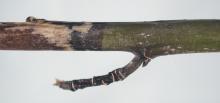Cause Various fungi such as Phoma, Phomopsis, and Cytospora. Neonectria ditissima (formerly Nectria galligena) is a problem on native dogwood. Usually these fungi are opportunistic and are able to attack only trees weakened by drought, cold, root problems, or wounds and mechanical injury. A canker of Cornus nuttallii has been described on wounded trees associated with land clearing in southern British Columbia caused by Dothichiza ambigua (formerly Sclerophoma ambigua).
Symptoms Leaf scorch, wilt, or leaf death may be the first indication that something is wrong. Examining the affected branch reveals a sunken dark brown canker with a sharp border between diseased and healthy tissue. Smaller branches may be girdled by the canker, resulting in dieback of everything distal to the canker.
Nectria canker - Small depressed areas of bark around a wound or at the base of a dead branch. The bark over the canker becomes darker than normal and cracked at the edges. Older cankers are often a series of target-like rings or may be completely covered by old bark. Small, red, round perithecia might be seen on some cankers.
Dothichiza canker-Young cankers appear as slightly sunken areas in the bark. Older cankers have bark that is dead and cracked in the center. Beneath the canker, the wood is usually stained grayish-brown. Cankers may occur at any height and may vary in length from a few inches to several feet. The large cankers are usually found only on one side of the stem. Cankers extend more rapidly vertically than laterally, resulting in confluence of cankers, but little girdling. Complete recovery of a tree seems to be rare, but may continue to live for several years. The fungus may fruit in the dead bark of the large cankers, but the presence of epiphytic lichens tends to obscure the pycnidia.
Cultural control
- Identify sources of stress and alleviate them when possible. For example, too much water will stress dogwood.
- Prune out and destroy affected branches.
Chemical control Fungicides are not warranted, since these fungi are not aggressive pathogens on native or cultivated dogwood.
Reference Funk, A. and Parker, A.K. 1972. A canker of western flowering dogwood caused by Sclerophoma ambigua n. sp. Canadian Journal of Botany 50:1623-1625.


